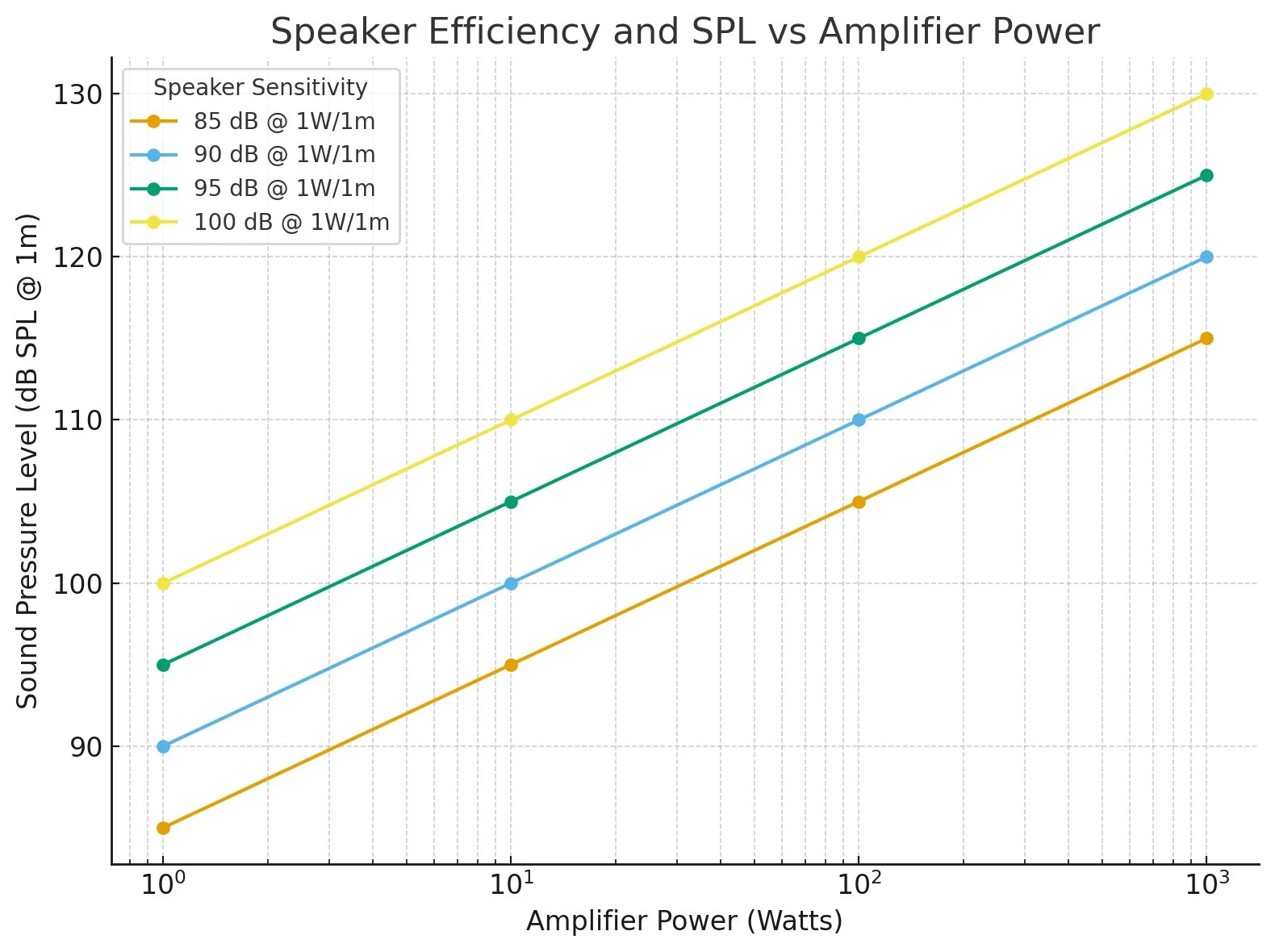Speaker Efficiency
From time to time, someone will ask me to explain the science of loudspeaker efficiency and what it means in real life.
The outcome, although highly simplified, is that a more efficient speaker is louder at the same input level than a less efficient speaker. For those looking for the shortest possible answer, there you are and thanks for coming.
For the rest, let’s explore a bit of what brings this about, the benefits, detriments and if we should really be concerned.
Defining Speaker Efficiency
In its most basic form, speaker efficiency is the ratio of acoustic power output to electrical power input, expressed as a percentage:
Efficiency = Acoustic Power Output divided by Electrical Power Input times 100
Because speakers convert only a small portion of electrical energy into sound (the rest becomes heat), efficiency values are typically quite low — often less than 5%, and usually closer to 0.1–2% for most consumer loudspeakers.
Clear like mud right?
Let’s restate this in terms that may make more practical sense.
Measurement Standards: Sensitivity vs. Efficiency
While “efficiency” is technically the ratio above, in practical audio work, it’s more common to describe a speaker’s sensitivity, which is related but easier to measure.
Sensitivity Measurement
Definition: The sound pressure level (SPL) produced by a speaker when driven with 1 watt of power and measured 1 meter away.
Units: Decibels (dB), written as dB SPL @ 1W/1m.
Typical range:
• Low-efficiency speakers: 82–88 dB SPL @ 1W/1m
• High-efficiency speakers: 92–100+ dB SPL @ 1W/1m
For example, a speaker rated at 87 dB produces a sound pressure level of 87 decibels when fed one watt and measured at one meter distance.
A 97 dB speaker will sound roughly twice as loud with the same power input (since every 10 dB increase represents about a doubling in perceived loudness).
What Impacts a Speaker’s Efficiency?
Several physical and design factors determine how efficiently a speaker can convert electrical energy into sound:
a. Driver Design
• Voice Coil & Magnet: Stronger magnetic fields (from larger or higher-grade magnets) improve motor efficiency, helping the cone move more easily and responsively.
• Cone Mass: Lighter cones require less energy to move, improving efficiency, but may reduce low-frequency extension and introduce coloration.
• Suspension Stiffness: A stiffer suspension resists motion (lower efficiency) but may control cone movement better, reducing distortion.
b. Enclosure Design
• Horn Loading: Horn speakers use an acoustic horn to couple the driver to the air more effectively, greatly increasing efficiency (often 100 dB or more).
However, they require large enclosures and careful design to avoid coloration.
• Sealed vs. Ported Boxes: Ported (bass-reflex) designs improve low-frequency output for a given input power, effectively increasing efficiency in that range.
c. Impedance and Electrical Design
• Lower impedance speakers (e.g., 4Ω vs. 8Ω) draw more current at the same voltage, which can slightly increase output, but only if the amplifier can handle it efficiently.
d. Frequency Range and Bandwidth
• A driver optimized for a narrow band (e.g., midrange horn) can be more efficient than one covering the full spectrum (e.g., a woofer), because energy is focused in one region.
Benefits of High-Efficiency Speakers
1. Require Less Amplifier Power:
• A more efficient speaker can reach the same volume with far less power.
Example:
• 87 dB speaker → needs 100 watts for a given loudness
• 97 dB speaker → needs only 10 watts for that same loudness
(Every 3 dB increase halves the required power.)
2. Better Dynamic Headroom:
• Since they require less power, amplifiers driving efficient speakers are less likely to clip, improving transient response and dynamics.
3. Ideal for Low-Power Amplifiers:
• Especially beneficial for tube amps and Class A designs, which often output lower wattage but deliver superior tonal quality.
4. Lower Distortion at High Volumes:
• Less electrical power means less heat buildup in voice coils, reducing thermal compression (where speakers lose efficiency as they warm up).
Drawbacks and Trade-Offs of High Efficiency
1. Physical Size and Design Complexity:
• Horns or large enclosures are often required to achieve high efficiency, making such systems bulky and expensive.
2. Limited Bass Extension:
• Efficient speakers often trade low-frequency response for sensitivity.
Deep bass requires large cone excursions, which typically reduce efficiency.
3. Coloration and Directivity:
• Horns, while efficient, can introduce coloration (resonances) and have highly directional dispersion, making placement and room acoustics critical.
4. Cost and Material Constraints:
• High-efficiency components (strong magnets, rigid light cones) are more expensive and harder to engineer for flat response.
Wrapping Up
| Metric | Low Efficiency | High Efficiency |
|---|---|---|
| SPL @ 1W -/ 1m | 82 - 88 dB | 92 - 100+ dB |
| Amplifier Power Requirement | High | Low |
| Enclosure Size | Compact | Large |
| Low Frequency Bass | Deeper | Often Limited |
| Distortion at High Volume | Higher | Lower |
| Optimal Use | Modern solid-state amps, compact systems | Tube amps, live sound, studio monitors |
Efficiency measures energy conversion (electrical → acoustic).
Sensitivity quantifies the resulting sound level for 1W at 1m.
Higher efficiency means louder sound with less power, but often larger size and design compromises.
The ideal efficiency depends on the application:
High-efficiency systems shine in live or tube-amp setups.
Low-to-moderate efficiency is acceptable in compact, full-range home or studio speakers where fidelity and size matter more than sheer output.
If you like what I do here for you, please become a supporter on Patreon. Your monthly contribution makes an enormous difference and helps me keep things going. To become a Patreon Patron, just click the link or the button below. Always feel comfortable to send in a question or to post a comment. I read them all and respond as appropriate. Thanks for your support of my work. I’m Ross Chevalier and I look forward to sharing with you again soon.


